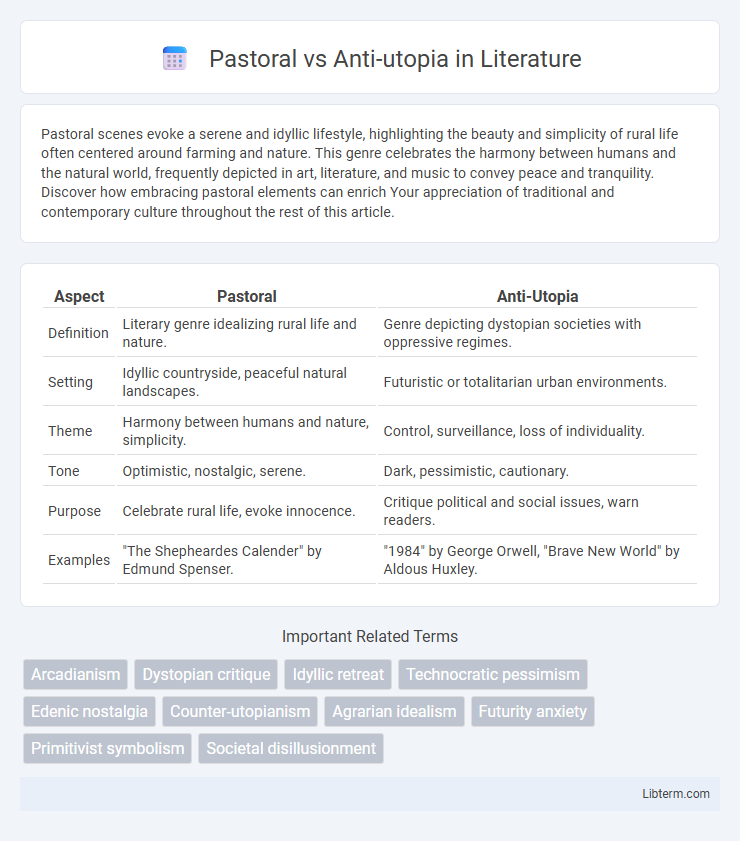Pastoral scenes evoke a serene and idyllic lifestyle, highlighting the beauty and simplicity of rural life often centered around farming and nature. This genre celebrates the harmony between humans and the natural world, frequently depicted in art, literature, and music to convey peace and tranquility. Discover how embracing pastoral elements can enrich Your appreciation of traditional and contemporary culture throughout the rest of this article.
Table of Comparison
| Aspect | Pastoral | Anti-Utopia |
|---|---|---|
| Definition | Literary genre idealizing rural life and nature. | Genre depicting dystopian societies with oppressive regimes. |
| Setting | Idyllic countryside, peaceful natural landscapes. | Futuristic or totalitarian urban environments. |
| Theme | Harmony between humans and nature, simplicity. | Control, surveillance, loss of individuality. |
| Tone | Optimistic, nostalgic, serene. | Dark, pessimistic, cautionary. |
| Purpose | Celebrate rural life, evoke innocence. | Critique political and social issues, warn readers. |
| Examples | "The Shepheardes Calender" by Edmund Spenser. | "1984" by George Orwell, "Brave New World" by Aldous Huxley. |
Understanding Pastoral and Anti-utopia: Key Definitions
Pastoral literature idealizes rural life, emphasizing harmony with nature, simplicity, and tranquility as a counterpoint to urban complexity. Anti-utopia, or dystopia, depicts flawed societies marked by oppression, fear, and loss of individuality, revealing the dark consequences of supposed 'ideal' systems. Understanding pastoral highlights themes of purity and peace, while anti-utopia centers on critique and caution against societal decay.
Historical Origins of the Pastoral Tradition
The pastoral tradition traces its historical origins to ancient Greek and Roman literature, where poets like Theocritus and Virgil idealized rural life as a peaceful, harmonious escape from urban corruption and social complexities. In contrast, anti-utopian narratives emerged primarily during the early modern period as critical responses to idealized visions of society, emphasizing dystopian themes and the consequences of political or technological control. These distinct origins highlight pastoral literature's roots in classical idealization of nature versus anti-utopia's foundation in socio-political critique.
Emergence and Evolution of Anti-utopian Narratives
Anti-utopian narratives emerged prominently in the 20th century as a response to the idealized visions of pastoral and utopian worlds, reflecting societal fears about totalitarianism, technological control, and environmental degradation. These stories evolved by deconstructing pastoral ideals, highlighting dystopian realities where oppressive systems undermine human freedom and ecological balance. Key works like Orwell's *1984* and Huxley's *Brave New World* illustrate the shift from idyllic pastoral fantasies to cautionary tales about societal collapse and loss of individuality.
Core Themes in Pastoral Literature
Pastoral literature centers on idealized rural life, emphasizing themes of harmony between humans and nature, simplicity, and innocence. It often contrasts the corrupting influence of civilization with the purity of countryside living, highlighting pastoral settings as a refuge from societal complexities. Core themes include the celebration of natural beauty, the nostalgia for an unspoiled world, and the romanticization of shepherd life as a symbol of peace and contentment.
Dominant Motifs in Anti-utopian Works
Anti-utopian works often emphasize motifs of totalitarian control, surveillance, and loss of individuality, highlighting the dangers of oppressive regimes. Themes of environmental degradation and technological dehumanization frequently dominate, illustrating societies stripped of natural harmony and personal freedom. These motifs contrast sharply with pastoral ideals by showcasing bleak, controlled settings where human connection and nature are suppressed.
Nature and Society: Contrasting Ideals
Pastoral literature idealizes nature as a harmonious refuge from societal corruption, portraying rural life as simple, pure, and closely connected to the land. In contrast, anti-utopian works depict nature as a hostile or indifferent force, exposing the failures and dystopian aspects of society through environmental decay or control. These contrasting ideals highlight pastoralism's celebration of natural balance against anti-utopia's critique of societal degradation manifested in disturbed natural order.
Critiques of Modernity in Pastoral and Anti-utopian Texts
Pastoral and anti-utopian texts offer contrasting critiques of modernity, with pastoral literature idealizing rural simplicity and harmony as a counterpoint to industrialization and urban alienation. Anti-utopian narratives expose the dangers of technological advancement, bureaucratic control, and loss of individuality, highlighting the dystopian consequences of unchecked modern progress. Both genres engage deeply with the discontents of modernity, reflecting anxieties about environmental degradation, social fragmentation, and the erosion of authentic human experience.
Pastoral Escapism vs. Anti-utopian Realism
Pastoral escapism idealizes rural life as a tranquil refuge, emphasizing harmony with nature and simplicity to evoke nostalgia and emotional solace. In contrast, anti-utopian realism depicts dystopian societies marked by oppressive control, socio-political decay, and bleak human conditions, exposing the dangers of totalitarianism and failed ideologies. The tension between pastoral escapism and anti-utopian realism highlights divergent literary approaches to critique contemporary realities, balancing idyllic retreat against urgent social critique.
Influential Works: Case Studies and Literary Examples
Thomas More's *Utopia* (1516) and Edward Abbey's *The Monkey Wrench Gang* (1975) represent influential works that define pastoral and anti-utopian themes, respectively. Pastoral literature idealizes rural life with works like Virgil's *Eclogues*, promoting harmony with nature, whereas anti-utopias such as George Orwell's *1984* critique dystopian control and societal failures. Margaret Atwood's *The Handmaid's Tale* combines dystopian elements with environmental decay, exemplifying modern anti-utopian critiques embedded in narrative form.
Impact on Contemporary Culture and Storytelling
Pastoral narratives evoke an idealized vision of nature and rural life, influencing contemporary culture by inspiring environmental awareness and a longing for simplicity in storytelling. Anti-utopian works challenge idealized futures by highlighting dystopian realities, prompting critical reflection on societal issues and technological advancements. The interplay between pastoral and anti-utopian themes enriches modern narratives, offering nuanced perspectives on humanity's relationship with nature and progress.
Pastoral Infographic

 libterm.com
libterm.com